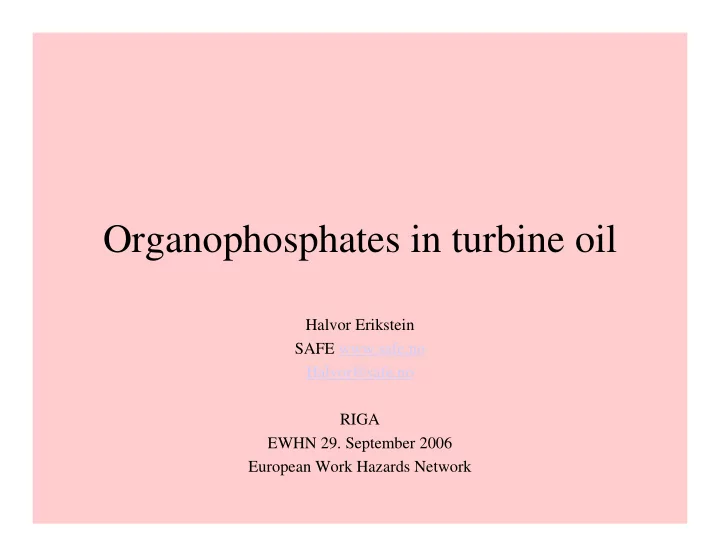

Organophosphates in turbine oil Halvor Erikstein SAFE www.safe.no Halvor@safe.no RIGA EWHN 29. September 2006 European Work Hazards Network
http://www.balpa.org/intranet/BALPA-Camp/The-Aircra/index.htm
Bilde hentet fra AOPIS: ”Contaminated Cabin Air – An Ongoing Health and Safety Issue, 2003” www.aopis.org
BLEED AIR Bilde hentet fra AOPIS: ”Contaminated Cabin Air – An Ongoing Health and Safety Issue, 2003” www.aopis.org
Bilde hentet fra AOPIS: ”Contaminated Cabin Air – An Ongoing Health and Safety Issue, 2003” www.aopis.org
No problems here? Bilde hentet fra AOPIS: ”Contaminated Cabin Air – An Ongoing Health and Safety Issue, 2003” www.aopis.org
To viktige additiver til bl.a MILSPEC 23699 1% N-phenyl-1-napthylamine 3% Tricresylfosfat (TCP) 10 isomerer (TOCP, DOCP, MOCP, TMCP, TPCP, DMCP, DPCP…….) Bilde hentet fra AOPIS: ”Contaminated Cabin Air – An Ongoing Health and Safety Issue, 2003” www.aopis.org
Castrol 5000 • MIL SPEC 23699 Sammenligning av to oljer som møter samme spesifikasjon Exxon 2380 Oppvarming 525 C C. Van Netten and V. Leung Appl.OccEnv.Hyg Vol 15(3)277-283,2000
Eksempel på omdanning under høy temperatur. Hvor mange andre slike mekanismer finnes?
BP Turbo Oil 25, 2197, 2380, 2389 • 2. COMPOSITION/INFORMATION ON INGREDIENTS Chemical Composition Synthetic base stock. (90 - 100%) • • Tris(methylphenyl) phosphate CAS No. EINECS No. 215-548-8 (<3%) 1330-78-5 • (contains <0.1% ortho isomer) • Mixed aromatic amines (<5%) • Hazardous Components • No component is present at sufficient concentration to require a hazardous classification.
Standard equipment: 3 turbines for power generators 2 turbines for pumps/compressors
Exhaust pipes from turbines
Same engines but different environment Indoor, ”high temperature”, Outside, cold air, high limited airflow, running for more air flow than 1000 hours without stopping. Much more tolerant to increased oil consumption and leakages Illustration AOPIS: ”Contaminated Cabin Air Illustration AOPIS: ”Contaminated Cabin Air – – An Ongoing Health and Safety Issue, 2003” An Ongoing Health and Safety Issue, 2003” www. www.aopis aopis.org .org
Bleed air
Pressure and temperature through a LM2500
Surface temp 500 – 700 o C
Turbinoljen skal både smøre og være kjøelmiddel
BLEED AIR • Bearings: The leaking points • On some offshore installations, Illustration Illustration AOPIS: ”Contaminated Cabin Air AOPIS: ”Contaminated Cabin Air – – An Ongoing Health and Safety Issue, 2003” An Ongoing Health and Safety Issue, 2003” www.aopis www. aopis.org .org the bleed air is used as instrument air and as breathing air for respiratory protection
”The Sump Philosophy”
Bearing #1, 2, 3, 4
Sump vent The lubrication of bearings OIL JET Air to create overpressure Seals 9000 rpm Return oil Cavity drain Ballbearing
Sump vent into the exhaust . Earlier routed ”out” Cavity drain; To the floor under Vent the turbine inside oil tank the hood! All seals leaks, but the amount varies
Turbine hood and generator layout
Inside the turbine hood Cavity drain/sump vent Also used to observe the condition of the sealings
Inside the turbine hood Many pipes and hoses which may leak.This area must be inspected while the engine is running.
Inside the turbine hood Many pipes and hoses which can leak and rupture. Vapors and aerosols hit hot surfaces
Inside the turbine hood Always some oil leakage and oil to be removed, sometimes >50 liters
The vacuum cleaner creates aerosols
Outside
Thermal degradation of lube oil • Some areas may have temperatures exceeding 500 o C • This temperature will create thermal decomposition of the oil components • Some of degradation products will be much more volatile and be vented out into the sump vent. • One must expect that new compounds will be created by different chemical reactions.
Volatile Vent system compounds Locally, very from hot surface breakdown of oil components: Inhalation Skin uptake Lube oil Local thermal degradation of lube oil
Hot zones
High temperature Friction pressure,
The 24 hours exposure Other sources for organophosphourous compounds • The flame retardant Pyrovatex is used in bedlinen and coveralls – Many reports on itchiness from bedlinen • Other oils and products with flame retardants based on organophosphourous compounds.
The absence of proof is not proof of absence
Recommend
More recommend